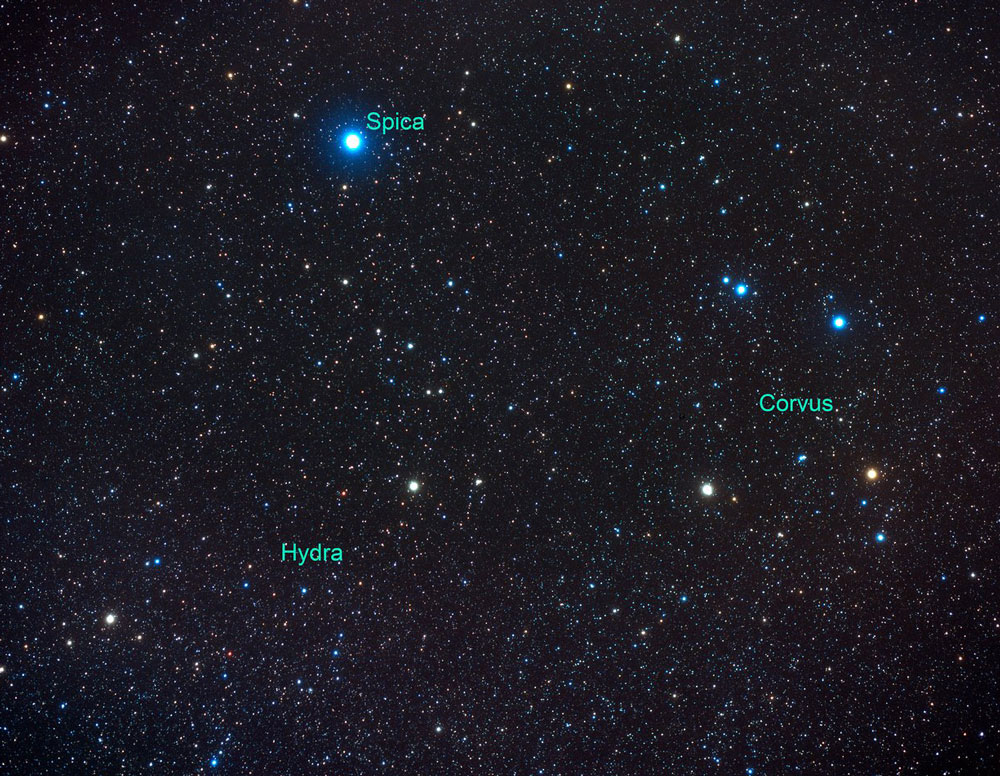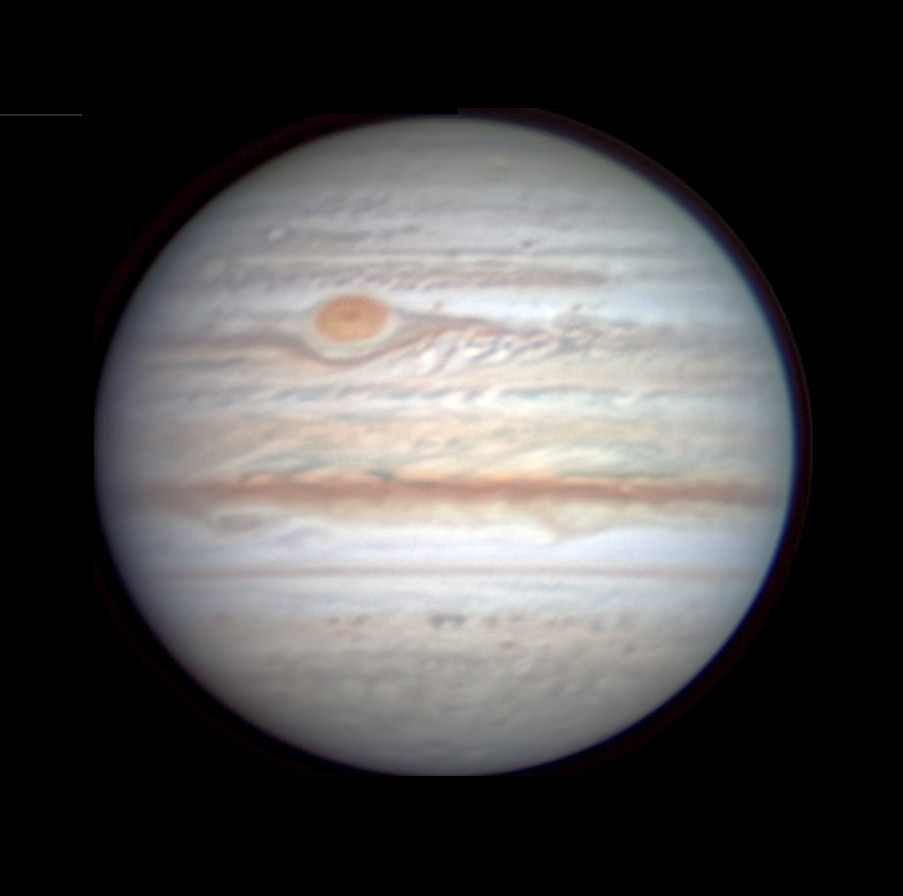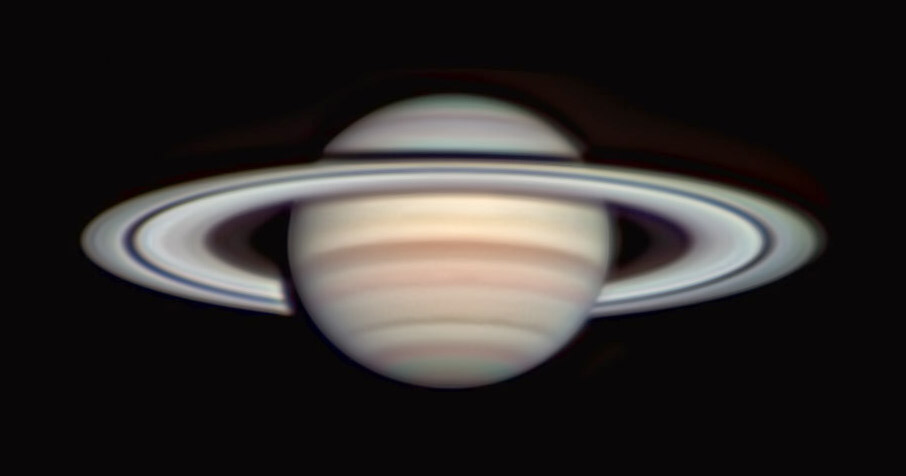FRIDAY, MAY 13
■ The almost-full Moon this evening shines in Virgo, with 1st-magnitude Spica to its lower right (by about 4°). Spot brighter Arcturus 30° to their upper left.
SATURDAY, MAY 14
■ Three zero-magnitude stars shine after dark in May: Arcturus high in the southeast, Vega lower in the northeast, and Capella in the northwest. They appear so bright because each is at least 60 times as luminous as the Sun, and because they're all relatively nearby: 37, 25, and 42 light-years from us, respectively.
SUNDAY, MAY 15
■ Total eclipse of the Moon tonight! The full Moon will turn into an eerie, luminous rotten orange among the stars for most of North America except the far northwest, and for all of Central and South America. Partial eclipse begins at 10:28 p.m. Eastern Daylight Time; total eclipse begins 11:29 p.m. EDT; mid-eclipse is at 12:12 a.m. EDT, total eclipse ends 12:54 a.m. EDT, and partial eclipse ends 1:56 a.m. EDT. Full timetable here.
Europe will catch mainly the final partial stage of the eclipse, before and/or during dawn on the 16th.
The Moon will be near the starry head of Scorpius. For lots more, see Witness a Total Lunar Eclipse on Sunday May 15–16. For instance, estimate the eclipsed Moon's brightness or darkness on the Danjon Scale. This eclipse is expected to be on the dark side; use the rating scale here. Will people with video cameras on their telescopes again record the pinpoint flash of a meteoroid strike on the Moon's dark surface?
Also: the edge of the dark Moon will occult the double star S672, magnitudes 6.3 and 8.9, separation 11 arcseconds, for telescope users in most of the US and Canada; map and timetables. (The timetable has two long sections, first for the disappearance, then the reappearance. The first two letters in each entry are the country abbreviation. More occultation info.)
Cloudy on the big night? A livestream of the eclipse from various places around the world starts at 2:15 May 16th UT (10:15 p.m. May 15th EDT), courtesy of Gianluca Masi and the Virtual Telescope Project.
MONDAY, MAY 16
■ The Moon, now a day after full, rises in late twilight with orange Antares just a couple degrees to its lower right. The head stars of Scorpius are farther to the Moon's upper right. Watch them all cross the sky together tonight.
TUESDAY, MAY 17
■ Arcturus, high in the southeast, forms the pointy end of the long, narrow Kite asterism: the central part of Bo
WEDNESDAY, MAY 18
■ Arcturus, a yellow-orange giant of spectral type K1.5 III, is sometimes described as ginger-ale colored. Especially if it's a ginger-ale drop in the orange light of the setting Sun.
Lower right of Arcturus by about three fists is springtime Spica, a definite color contrast with it (binoculars help).
Lower left of Spica, by a fist or a bit more, is the four-star pattern of Corvus the Crow, as imaged here:

At full size, this image by Akira Fujii shows stars as faint as 10th magnitude. (Right-click on it and choose "open in a new tab").
THURSDAY, MAY 19
■ This is the time of year when Leo the Lion starts walking downward toward the west, on his way to departing into the sunset in early summer. After dark, spot the brightest star fairly high in the west-southwest. That's first-magnitude Regulus, Leo's forefoot.
FRIDAY, MAY 20
■ Spring is advancing, and Vega is now nicely up in the east-northeast after dark. Look for its faint little constellation Lyra, the Lyre, hanging down from it with its bottom canted to the right. Lyra's leading stars form a little equilateral triangle with Vega as one corner, and a parallelogram dangling from the triangle's bottom.
■ Look 14° (almost a fist and a half at arm's length) upper left of Vega for Eltanin, the 2nd-magnitude nose of Draco the Dragon. Closer above and upper left of Eltanin are the three fainter stars forming the rest of Draco's stick-figure head, also called the Lozenge. Draco always points his nose to Vega no matter how he's oriented. He seems curious about it. Do dragons eat jewels? He has never made a move on it yet.
The faintest star of Draco's head, opposite Eltanin, is Nu Draconis. It's a fine, equal-brightness double star for binoculars (separation 61 arcseconds, both magnitude 4.9). The pair is 99 light-years away. Both are hot, chemically peculiar type-Am stars somewhat larger, hotter, and more massive than the Sun.
SATURDAY, MAY 21
■ With summer still a month away (astronomically speaking), the last star of the Summer Triangle still doesn't rise above the eastern horizon until about 10 or 11 p.m. That's Altair, the Triangle's lower right corner. Watch for Altair to clear the horizon three or four fists at arm's length to Vega's lower right.
■ Before and during Sunday's dawn, the last-quarter Moon hangs under Saturn — by about the width of three fingers at arm's length for most of North America. How far into dawn can you keep Saturn, 1st magnitude, in definite sight?
This Week's Planet Roundup
Mercury is hidden in the glare of the Sun.
Venus and Jupiter, magnitudes –4.0 and –2.2 respectively, are the bright "Morning Stars" low in the east in early dawn. Venus is the lower one; Jupiter is increasingly far to Venus's upper right. They're separated by 13° on the morning of May 14th, widening to 20° by the 21st.

Go lives in the southern Philippines at latitude 10° north, where the ecliptic runs at a high angle up from the horizon. So Jupiter was a good 30° high when he took this image. Those of us at more northerly latitudes have a few weeks to go before Jupiter is in that decent a telescopic position before dawn.
Mars, magnitude +o.8, is closer to the upper right of Jupiter. They're 9° apart on the morning of May 14th, closing to 5° on the 21st. Look early before the brightening dawn swallows it up.
Saturn, also magnitude +0.8, is a good 30° upper right of Mars.

Uranus and Neptune are still basically unobservable, low in the dawn.
All descriptions that relate to your horizon — including the words up, down, right, and left — are written for the world's mid-northern latitudes. Descriptions and graphics that also depend on longitude (mainly Moon positions) are for North America.
Eastern Daylight Time, EDT, is Universal Time minus 4 hours. (Universal Time is also called UT, UTC, GMT or Z time.)
Want to become a better astronomer? Learn your way around the constellations. They're the key to locating everything fainter and deeper to hunt with binoculars or a telescope.
This is an outdoor nature hobby. For an easy-to-use constellation guide covering the whole evening sky, use the big monthly map in the center of each issue of Sky & Telescope, the essential magazine of astronomy.
Once you get a telescope, to put it to good use you'll need a detailed, large-scale sky atlas (set of charts). The basic standard is the Pocket Sky Atlas (in either the original or Jumbo Edition), which shows stars to magnitude 7.6.

Next up is the larger and deeper Sky Atlas 2000.0, plotting stars to magnitude 8.5; nearly three times as many. The next up, once you know your way around, are the even larger Interstellarum atlas (stars to magnitude 9.5) or Uranometria 2000.0 (stars to magnitude 9.75). And be sure to read How to Use a Star Chart with a Telescope. (It applies just as much to charts on your phone or tablet as to charts on paper.)
You'll also want a good deep-sky guidebook. A beloved old classic is the three-volume Burnham's Celestial Handbook. An impressive more modern one is the big Night Sky Observer's Guide set (2+ volumes) by Kepple and Sanner.
Can a computerized telescope replace charts? Not for beginners, I don't think, and not on mounts and tripods that are less than top-quality mechanically, meaning heavy and expensive. And as Terence Dickinson and Alan Dyer say in their Backyard Astronomer's Guide, "A full appreciation of the universe cannot come without developing the skills to find things in the sky and understanding how the sky works. This knowledge comes only by spending time under the stars with star maps in hand."
![]() Audio sky tour. Out under the evening sky with your
Audio sky tour. Out under the evening sky with your
earbuds in place, listen to Kelly Beatty's monthly
podcast tour of the heavens above. It's free.
"The dangers of not thinking clearly are much greater now than ever before. It's not that there's something new in our way of thinking, it's that credulous and confused thinking can be much more lethal in ways it was never before."
— Carl Sagan, 1996
"Facts are stubborn things."
— John Adams, 1770
 6
6









Comments
Anthony Barreiro
May 13, 2022 at 6:20 pm
Corvus gets quite a bad rap! First the poor Crow gets busted for waiting for some grapes to ripen, thus dawdling bringing Crater the Cup to Apollo, and blaming Hydra the Snake for the delay; then the Crow is accused of planning to steal Spica.
I've been following Vesta through 10x42 binoculars since last week; she passed Saturn on Saturday May 7 and has kept on trucking eastward. I've been looking for Neptune, but no luck yet. Too low to see through the haze and light pollution before astronomical dawn, and then once he's high enough, the sky is too bright. I'll keep looking, hoping to see the conjunction of Mars and Neptune Wednesday May 18.
You must be logged in to post a comment.
Rod
May 13, 2022 at 9:46 pm
Anthony, good note on Mars and Neptune on 18-May. I may be able to see the pair using my 90-mm refractor at 71x, both in the FOV (about 32 arcminute or less separation between the pair). Comet 22P/Kopff is a bit more than 1-degree from Neptune as well to the right. theskylive.com shows 11.5 magnitude so my 10-inch could view all three but setting up the beast at 0400 or so EDT is more than I desire 🙂 A good viewing time at my location in MD is about 0500 EDT. I hope to enjoy some of the total lunar eclipse coming on Sunday night and early Monday morning, however, current weather forecast looks poor with clouds - mostly or partly cloudy. I plan to post some observing reports if I see anything 🙂 Here is to clear skies.
You must be logged in to post a comment.
mary beth
May 16, 2022 at 1:55 pm
Absolutely perfect and delightful evening of eclipse viewing in Texas! The weather was perfect 81° and oddly not too humid for Houston, perfectly clear and a nice soft breeze from the S/SW about 10 mph. Could not have asked for better conditions! The view from my front yard was quite spectacular. The moon rose with such a lovely orange color and then turned a butter yellow before the partial phase began. It definitely was slightly and noticeably bigger. Everything I read said the partial would start at 9:27 PM but I felt like at about 9:15 PM I was able to see some shadowing. Some good photographs were taken with just our phones, a couple of neighbors had some new high-tech phones that got some real good images. But the best thing was just staring at it with her own eyes, marveling at God’s beautiful creation! What a treat! Hope others enjoyed as well, was thinking of all ‘us regulars’!
You must be logged in to post a comment.
Rod
May 16, 2022 at 6:55 pm
very good mary beth 🙂 I enjoyed t-storms, rain, and clouds during the total lunar eclipse 🙂 Perhaps tomorrow morning I may view Mars and Neptune, about 49 arcminutes apart in the sky near 0500 EDT. Next day too on Wednesday when they are closer.
You must be logged in to post a comment.
Rod
May 18, 2022 at 6:22 am
Observed 0500-0530 EDT/0900-0930 UT. Sunrise 0552 EDT/0952 UT. I could see the conjunction of Mars and Neptune this morning at 71x. Mars distinct planetary shape and orange-red, Neptune blue dot. They were separated by about 31.5 arcminute in their position in the sky, true FOV a bit more than 60 arcminute using the TeleVue 14-mm Delos eyepiece and my 90-mm refractor telescope. Mars at 1.531 AU, Neptune 30.372 AU. At Jupiter, cloud belts visible, 4 Galilean moons, two were very close and almost in vertical alignment. At Saturn I could see the rings and Titan easily. Venus bright gibbous shape at 15 arcsecond angular size and 73.62% illuminated, apparent magnitude -4.1. Mostly clear skies, temperature 10C with winds north at 6 knots. 5 planets observed along the ecliptic and waning gibbous Moon in Sagittarius viewed as well. Craters prominent along terminator line and Tycho crater. 4 moons at Jupiter observed, one moon at Saturn, and our Moon for a total of 6 moons viewed. I should get bonus points for viewing 5 planets and 6 moons this morning
You must be logged in to post a comment.
mary beth
May 18, 2022 at 1:28 pm
11 bonus points for you, hopefully redeemable for clear skies with the Weatherman on the next lunar eclipse in November!
You must be logged in to post a comment.
You must be logged in to post a comment.